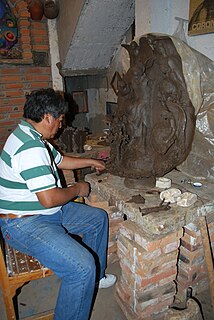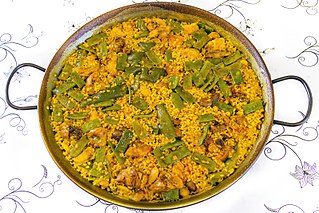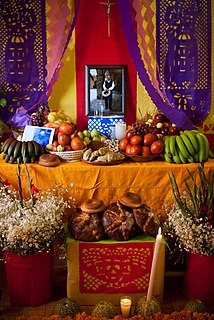
The Soteno family of Metepec is one of the main families of ceramic artisans specializing in sculptures called Trees of Life which have made the town found in the State of Mexico one of Mexico’s main ceramic centers. The Tree of Life is a complicated colorful sculpture which was developed from the creation of candlesticks. The family’s prominence began with Modesta Fernández Mata, the mother, grandmother and great-grandmother of the Soteno potters today, who began experimenting making more decorative items along with utilitarian ones. The generations after her have learned the craft and improved on it starting as children working with parents and grandparents. The two most notable members of the family are Tiburcio and Oscar, second and third generation respectively, who have won various awards and have their works in collections worldwide.
Alberto Bautista Gómez is a Mexican potter from Amatenango del Valle, Chiapas. It is a Tzeltal community with a long tradition of pottery making, many learning the craft as children. His grandmother taught him to work with clay when he was fifteen, first making cookware and flowerpots. He then moved on to more decorative items, such as figures of birds, women and children, which became imitated by others in the community. He then began to create lamps in the form of giant tigers and tiger heads, painted in natural colors, which became prized for their artistic quality and have since evolved into sculptures in their own right. Other innovations of his have been to create large vases called “cántaros” with raised designs, and the addition of colored sand and crushed stone to create darker colors and different textures. He works with his wife, Simona López Pérez, obtaining his materials locally and creating most of his works by hand, occasionally using some crude molds.
Elena Felipe and Bernadina Rivera are Purepecha Mexican potters from Huancito, Michoacán known for making towers of stacked storage containers. The two are native speakers of the indigenous language and are sisters-in-law, with Elena married to Bernadina’s brother. Both learned pottery as children and are passing the tradition onto the next generation.
Esther Medina Hernández is a Mexican potter, known for her barrel cactus shaped wares.

The Aguilar family of Ocotlán de Morelos are from a rural town in the state of Oaxaca, Mexico. This town produced only utilitarian items until Isaura Alcantara Diaz began creating decorative figures with her husband Jesus Aguila Revilla. The couple taught their five daughters who continued innovating their own styles and then teaching the two generations after them. Two of the sisters, Guilliermina and Irene have been named “grand masters” by the Fomento Cultural Banamex, for their figures and sets of figures related to the life and traditions of Oaxaca, as well as Mexican icons such as Frida Kahlo and the Virgin of Guadalupe. The younger generations have made their own adaptations with some attaining their own recognition such as Lorenzo Demetrio García Aguilar and Jose Francisco Garcia Vazquez.

Hilario Alejos Madrigal is a Mexican potter from a small town in the state of Michoacán, known for his “pineapple” ceramic wares. The name comes from the original form created by his mother, potter Elisa Madrigal Martinez, who created punch bowls in the shape of pineapples. Alejos Madriga’s variations include bowls, candelabras and more, with the version done in a green glaze be best known. Alejos Madrigal has won awards for his work, which is featured on the cover of large reference book Grandes Maestros del Arte Popular Mexicano by Fomento Cultural Banamex.
Leonarda Estrella Laureano is a Mayo Mexican potter from Capomos, El Fuerte in Sinaloa.
Salvador Vázquez Carmona is a Mexican potter from the crafts town of Tonalá, Jalisco, who specializes in a regional ceramic style called bruñido. He has been called the best artisan in Tonalá and has trained a number of other notable potters.

Florentino Jimón Barba is a Mexican potter based in Tonalá, Jalisco.
José García Antonio is a Mexican potter from San Antonio Castillo Velasco in the municipality of Ocotlán, Oaxaca, a town noted for its handcrafts. He still has is house and workshop there, located beyond the church behind a tall gate that hides what is inside.
Cesar Torres Ramírez is a Mexican potter who specialized in the country Talavera pottery tradition. His work has been featured in books such as Cerámica Y Cultura: The Story of Spanish and Mexican Mayólica of the Museum of International Folk Art in New Mexico, in the Grandes Maestros de Arte Popular Mexicano as a “grand master” by the Fomento Cultural Banamex and as one of Mexico’s best artisans in a documentary on Canal Once in Mexico.
Celso Camacho Quiroz is a fourth-generation Mexican potter who works in Metepec, in the State of Mexico. His specialty is the making of large cooking vessels called “cazuelas,” traditionally used to cook mole and rice, but he also makes a number of other utilitarian and decorative pieces. His work has been recognized with awards such as the Gran Premio de Arte Popoular from FONART in 1999 and being named a “grand master” by the Fomento Cultural Banamex in 2003.

Apolinar Hernandez Balcazar is a Mexican basket maker from San Martin Coapaxton, Tenancingo, State of Mexico, whose work has won various national awards.

Fortunato Moreno Reinoso is a Mexican artisan from Ixmiquilpan, Hidalgo in central Mexico. He is noted for his work in reeds and bamboo, a tradition from the Otomi group to which he belongs, learning it from his father and grandfathers.
Ángel Gil is a Mexican artisan who specialized in creating items from ixtle fiber. He has been named a “grand master” of Mexican handcrafts by the Fomento Cultural Banamex.
The Pineda Palacios is a Mexican family of artisans which specializes in the making of nativity scenes with figures made from palm fronds. Their work has been recognized by being named “grand masters” of Mexican handcrafts by the Fomento Cultural Banamex.
The Aguirre family is a Mexican artisan family specializing in inlaid wood items. Two of the family members, Silvano and Francisco, have been named "grand masters" of Mexican folk art by the Fomento Cultural Banamex.
Ascensión de la Cruz Morales is a Mexican artisan from the small community of San Francisco Ocotán, Durango who specializes in making musical instruments such as violins, guitars, tolochoches(similar to a cello) and harps. His work has earned him the title of “grand master” from the Fomento Cultural Banamex.
Francisco Coronel Navarro is a Mexican artisan who work in lacquer ware and the revival of using gold leaf in this craft earned him the National Prize for Arts and Sciences in Mexico, among other recognitions. He was born in a very poor family in Olinalá, Guerrero, a town noted for its history with gold and lacquer work. Beginning at age seven, he created lacquer pieces for sale, reintroducing gold leaf into his works in the 1970s. His work has been exhibited in Mexico and the United States, with two pieces made as gifts for Queen Elizabeth II and Pope John Paul II.







